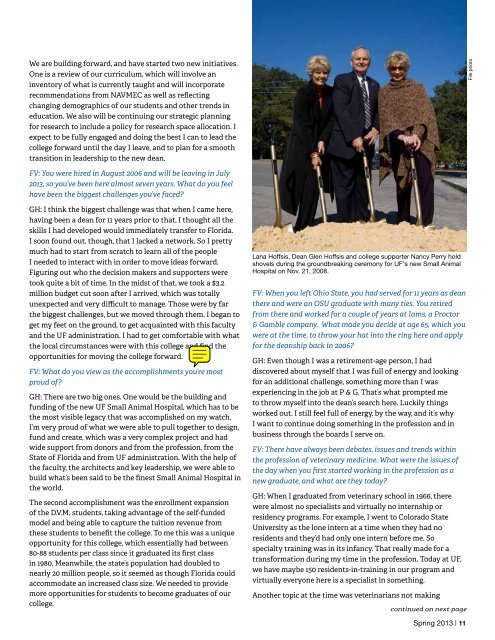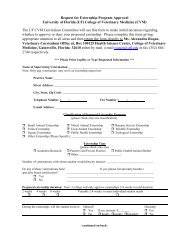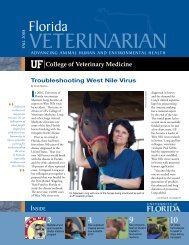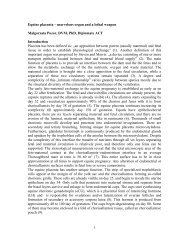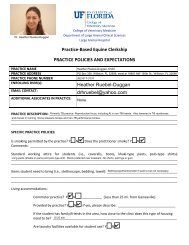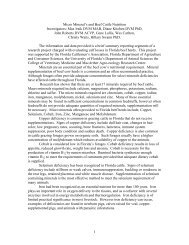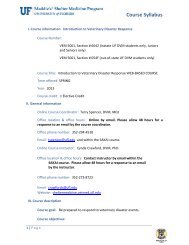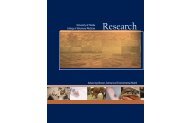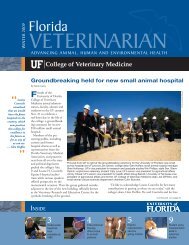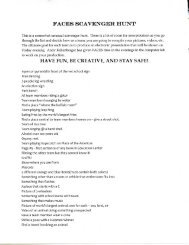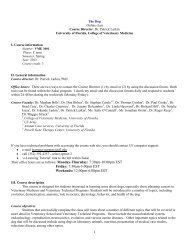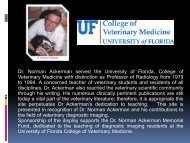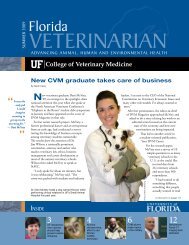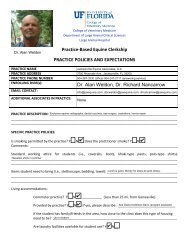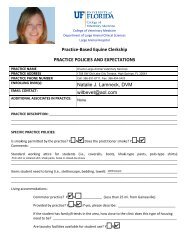Veterinarian - University of Florida College of Veterinary Medicine
Veterinarian - University of Florida College of Veterinary Medicine
Veterinarian - University of Florida College of Veterinary Medicine
- No tags were found...
Create successful ePaper yourself
Turn your PDF publications into a flip-book with our unique Google optimized e-Paper software.
We are building forward, and have started two new initiatives.One is a review <strong>of</strong> our curriculum, which will involve aninventory <strong>of</strong> what is currently taught and will incorporaterecommendations from NAVMEC as well as reflectingchanging demographics <strong>of</strong> our students and other trends ineducation. We also will be continuing our strategic planningfor research to include a policy for research space allocation. Iexpect to be fully engaged and doing the best I can to lead thecollege forward until the day I leave, and to plan for a smoothtransition in leadership to the new dean.File photoFV: You were hired in August 2006 and will be leaving in July2013, so you’ve been here almost seven years. What do you feelhave been the biggest challenges you’ve faced?GH: I think the biggest challenge was that when I came here,having been a dean for 11 years prior to that, I thought all theskills I had developed would immediately transfer to <strong>Florida</strong>.I soon found out, though, that I lacked a network. So I prettymuch had to start from scratch to learn all <strong>of</strong> the peopleI needed to interact with in order to move ideas forward.Figuring out who the decision makers and supporters weretook quite a bit <strong>of</strong> time. In the midst <strong>of</strong> that, we took a $3.2million budget cut soon after I arrived, which was totallyunexpected and very difficult to manage. Those were by farthe biggest challenges, but we moved through them. I began toget my feet on the ground, to get acquainted with this facultyand the UF administration. I had to get comfortable with whatthe local circumstances were with this college and find theopportunities for moving the college forward.FV: What do you view as the accomplishments you’re mostproud <strong>of</strong>?GH: There are two big ones. One would be the building andfunding <strong>of</strong> the new UF Small Animal Hospital, which has to bethe most visible legacy that was accomplished on my watch.I’m very proud <strong>of</strong> what we were able to pull together to design,fund and create, which was a very complex project and hadwide support from donors and from the pr<strong>of</strong>ession, from theState <strong>of</strong> <strong>Florida</strong> and from UF administration. With the help <strong>of</strong>the faculty, the architects and key leadership, we were able tobuild what’s been said to be the finest Small Animal Hospital inthe world.The second accomplishment was the enrollment expansion<strong>of</strong> the D.V.M. students, taking advantage <strong>of</strong> the self-fundedmodel and being able to capture the tuition revenue fromthese students to benefit the college. To me this was a uniqueopportunity for this college, which essentially had between80-88 students per class since it graduated its first classin 1980. Meanwhile, the state’s population had doubled tonearly 20 million people, so it seemed as though <strong>Florida</strong> couldaccommodate an increased class size. We needed to providemore opportunities for students to become graduates <strong>of</strong> ourcollege.Lana H<strong>of</strong>fsis, Dean Glen H<strong>of</strong>fsis and college supporter Nancy Perry holdshovels during the groundbreaking ceremony for UF's new Small AnimalHospital on Nov. 21, 2008.FV: When you left Ohio State, you had served for 11 years as deanthere and were an OSU graduate with many ties. You retiredfrom there and worked for a couple <strong>of</strong> years at Iams, a Proctor& Gamble company. What made you decide at age 65, which youwere at the time, to throw your hat into the ring here and applyfor the deanship back in 2006?GH: Even though I was a retirement-age person, I haddiscovered about myself that I was full <strong>of</strong> energy and lookingfor an additional challenge, something more than I wasexperiencing in the job at P & G. That’s what prompted meto throw myself into the dean’s search here. Luckily thingsworked out. I still feel full <strong>of</strong> energy, by the way, and it’s whyI want to continue doing something in the pr<strong>of</strong>ession and inbusiness through the boards I serve on.FV: There have always been debates, issues and trends withinthe pr<strong>of</strong>ession <strong>of</strong> veterinary medicine. What were the issues <strong>of</strong>the day when you first started working in the pr<strong>of</strong>ession as anew graduate, and what are they today?GH: When I graduated from veterinary school in 1966, therewere almost no specialists and virtually no internship orresidency programs. For example, I went to Colorado State<strong>University</strong> as the lone intern at a time when they had noresidents and they’d had only one intern before me. Sospecialty training was in its infancy. That really made for atransformation during my time in the pr<strong>of</strong>ession. Today at UF,we have maybe 150 residents-in-training in our program andvirtually everyone here is a specialist in something.Another topic at the time was veterinarians not makingcontinued on next pageSpring 2013 | 11


